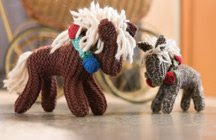
When it came time to write a post for April Fool's Day, I cast around for some kind of knitted shenanigans. I googled for knitted jokes or knitted practical jokes to no avail; all I came up with some painfully unfunny knitting-themed cartoons and a lot of horrible projects that were probably designed and knitted in all seriousness. So I decided that today I'd feature some knitted items that look like an April Fool's jokes along with some accompanying tips to help you keep your projects from turning out like them. I got all these photos from the now defunct You Knit What??, which was operational between April 21, 2005 and August 3, 2006, and which was one of my sources of inspiration for the concept of this blog. I realized one night last November that it had been the only knitting blog I ever followed and that I still missed it more than six years after its last update.
The above picture is, of course, the first of my cautionary tales rendered in yarn. Knitting can't solve all your problems. If you suffer from self-hatred this abject, it's time to get some therapy.

One's sweater should not house more than three people.

These rainbow flag hotpants may be perfect for the Gay Pride parade, but if you're thinking of wearing them in everyday life... just remember, there are better ways to show gay pride and support for gay marriage, such as by knitting the Rainbow Pride Scarf I posted about two days ago, or by signing petitions, writing to your elected officials, and donating your money or your time to gay rights organizations. I think we can all agree that these will be more constructive and becoming actions than donning rainbow hot pants.


If you're making a sweater, make a sweater. Don't get too lazy to make the whole thing and think no one will notice.

If you're a male knitter, know that you don't have to prove your masculinity to anyone. You are armed with two pointed pieces of metal, and you can make a cashmere sweater for anyone you're dating, which will get you thanked in kind. You're not only a man, you're the man. Put away those phallic size 50mm knitting needles.

One's knitted outfit should not land one on the endangered species list.

One's knitted dress should not look like it was knitted out of bathmat.

One's knitted hat should not give anyone retina burn.

Don't think you're immune to Christmas sweaters because you're not Christian. Ugly holiday sweaters are equal opportunity.

Don't knit for your pets. Or at least not for your cat. It'll all be fun and games until you wake up in the night and find Malibu Tabby here is eating your face.

Don't let your fingerless gloves migrate to any other part of your body.

Don't get so anxious to use up your stash that you put it all into the same garment, willy nilly.

Felting is not some magical process that turns a horrible knitting project into a good one.

Sewing buttons randomly all over a badly shaped and fitted item won't turn it into a cute, smart item.

Porn stars don't have to knit their own costumes. If your director is telling you otherwise, it's time to get a new agent.

If the model has to adopt some tortured pose to keep her top from falling off, so will anyone you make this for.


Some things should never be made from yarn. Like jewelry. And hair.

If you're a female knitter, I am sure you've heard of the Sweater Curse. Well, it's nothing compared to the Poncho Curse. Knit your man any poncho, let alone one that matches yours, and suddenly he'll move to a new country because he "needs some space", then he'll change his name, join some sort of right-wing militia, and claim your two children aren't his because he's never met you before in his life and besides, that he's gay.

Adding a furry bra to a sheer sweater isn't going to make it look more modest, but rather less so. Just wear a cami tank under that bad girl.

Don't use your knitting to discipline your children. It will mean you'll have to start a therapy fund for each of them as well as a college/university fund. And you've got yarn to buy.
I hope we've all learned a little something today.






























